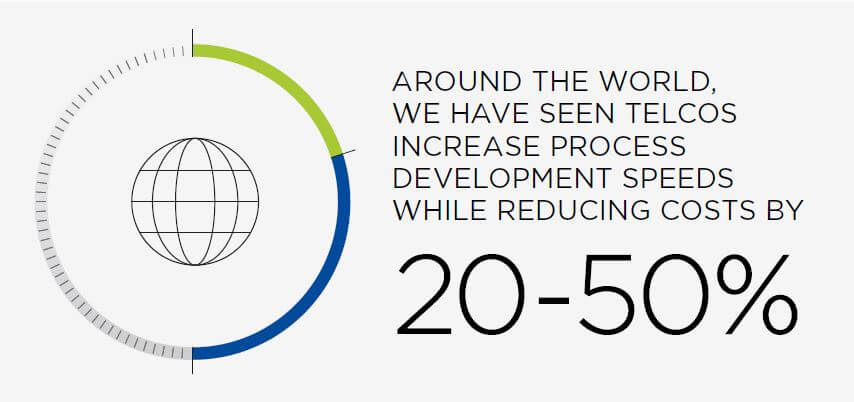A new era of change in telecoms requires a new technology estate to benefit the customer and reduce costs
Next-generation cloud computing technologies will enable telecom operators to seize a myriad of opportunities both in the telco marketplace and for internal optimization. As the next wave of connectivity enters the business landscape, telecommunications organizations that modernize their technology estate will be in a position to deliver best in class services and radically alter the way they operate.
“The telecom industry has all the technical capabilities to succeed in a 5G world, but it will need to adapt to the changing environment very quickly,” technology analysts Gartner said in a report of the impact 5G will have on global operators. “Given the diverse enterprise client base, operators must shift from a product-based strategy to a customer-based strategy focused on the unique needs of each client,” Gartner adds of how the telco enterprise will need processes and technologies that enable it to be highly customer-centric.
Telecoms organizations are already market leaders at customer care, but 5G adds a new layer of complexity to the customer focus challenge. As the infrastructure for what is commonly called the fourth industrial revolution, 5G will bring the telecoms industry into a closer and more vital relationship with vertical markets such as manufacturing, automotive, transportation, healthcare, agriculture, and retail. Connected devices will reshape the way communities travel, make things, return to health, acquire goods, and how the food arrives on their tables. Those businesses and their connectivity demands will be new and, in some cases, unique to their markets. The telco providers will, therefore, need a business and technology architecture that is responsive to the demands of each of those markets. In the years to come, telcos will be responding to weather events in agriculture, supply chain demands in retail and manufacturing, and removing congestion from travel.
Working in this new, highly connected environment is changing the operating model for the sector. “Telcos face a set of industry-specific challenges, including those related to team structure, vendor management, risks and interdependencies, consistency, and culture and leadership,” says the Boston Consulting Group (BCG). “This last hurdle is especially high because many telcos have been doing business in much the same way for decades.” As BCG highlights, the sector has been operating without disruption to its business model for some time; as a result, the technology architecture of the operators has also remained in stasis.
“Revenue growth is so hard to come by that many telcos focus primarily on retaining customers and protecting the near-term revenue base. These priorities, combined with high capital expenditure costs (such as for network upgrades) and long payback periods, have led to a high intolerance for risk,” BCG says of why change has been hard to embrace. But if the telecoms sector is to seize the opportunities of 5G and new markets, then not changing their operating models is the risk.
BCG rightly indicates that telcos work in a market that demands high Capex investments and long slow returns from that investment, and 5G carries those same risks. However, the modernization of business processes and the technologies to underpin new procedures does not carry significant investment cost or risk. Cloud computing has lowered the cost of business change for telcos and many other sectors.
“Around the world, we have seen telcos increase process development speeds while reducing costs by 20% to 50%,” BCG reports. “Some have increased release cycle times for new products by a factor of ten and reduced marketing expenses by 60%.” Increasing the speed of delivery for new products and services whilst also reducing the spend on marketing is a clear example of how telecoms organizations can benefit from enterprise cloud adoption. In its major study Succeeding with CIO led Digital Transformation, industry analysts IDC discovered that cloud delivers benefits on four business issues: enhanced flexibility, cost control, tackling the skills gap and improving business resilience.

The IDC study, Succeeding with CIO led Digital Transformation, found that organizations with a strong enterprise cloud estate were able “to restructure to match business needs” and that working with cloud providers ensured telco CIOs had access to skilled staff from the cloud provider, adding to their own teams and the business is able to respond to major events such as floods or pandemics. And all of this is done with greater clarity on the cost of the compute power the organization is using.
These benefits are in stark comparison to the existing technology landscape in telco providers. At present, according to BCG, a ”complex technology landscape creates challenges in and of itself. Incumbents typically have old and interrelated IT systems, which can complicate efforts to expose application programming interfaces and resolve integration issues.” In contrast, those organizations with a rich enterprise cloud computing estate are tackling business-wide issues of delivering new products, reducing the cost of doing business, gaining access to skilled technology workers, and have a strong disaster recovery platform in place.
Telcos that optimize the operations and technology architecture of their businesses will thrive in the fourth industrial revolution.
